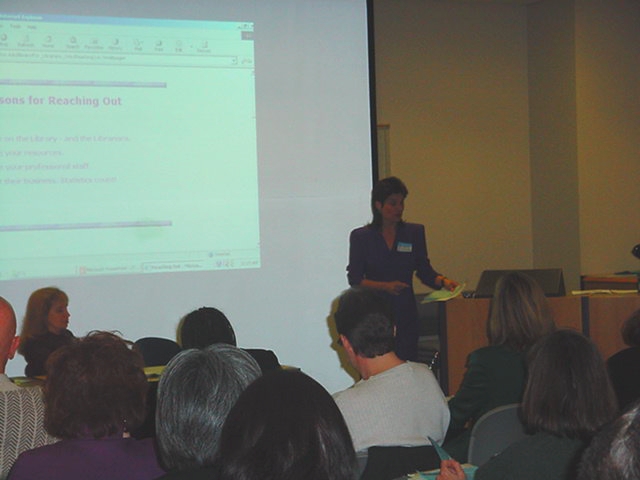
Julé Ketcham

Facilitator: Gale Burrows (Claremont Colleges)
Presenters: Julé Ketchum and Lorraine Gersitz (Cerritos College), Val Ontell (San Diego Mesa College), Gale Burrow (Claremont Colleges)
Ketchum and Gersitz discussed their no-cost or low-cost approaches to publicizing library instruction and library services in general. They emphasized to need to recall that faculty can be powerful library advocates, once you show them what the library can offer. Informing faculty of services will hopefully lead to more requests for instruction, an increase in student success, and ultimately, an enhanced budget.
Before diving in, Ketchum and Gersitz recommend considering what library services you wish to publicize more. As an activity, those in the audience were encouraged to consider their own institution’s services. Creating a brochure to hand out or publishing a newsletter that emphasizes what faculty will want were two ways to provide information that faculty could take with them. A web site that serves faculty as a ‘place of their own’ was also created in order to demonstrate how the library can support faculty research and teaching responsibilities (http://www.cerritos.edu/library/) By request, Ketchum and Gersitz have made their presentation available: http://www.cerritos.edu/library/For_Librarians_Only/ReachingOut.html.
Approaching publicity systematically and sticking to a schedule was crucial to promoting their message. New faculty orientations, division meetings, and department meetings were three gatherings that Ketchum and Gersitz presented their message to. New faculty orientations provided a forum to showcase the library services and convey the message of librarians as partners in teaching to new, young faculty. Contacting the chair of particular divisions and presenting an update on library services was an effective way to showcase the library and put a face to the librarians. Department meetings held at the library at the request of Ketchum and Gersitz were a convenient way to provide demonstrations of online resources and showcase new books in a particular field. These presentations appeared to leave faculty impressed.
The ultimate results of their efforts were more requests for orientations, more resources guides created, more partnering with faculty, and a feeling of greater enthusiasm about the library. Specifically, requests for library counseling increased 700%. Unfortunately, their budget stayed the same.
Gale Burrows shared her experiences in providing orientation to faculty spread out over the seven libraries of the Claremont Colleges. For a new faculty orientation, Burrows described the wine and cheese reception that served as a forum for meeting new faculty and an effective means to ‘put a face’ on the library. In order promote the faculty and student workshops that are held, emails are sent to all faculty; copies were provided for audience members. Faculty appear to prefer emails, but only if they are sent out selectively, as Burrows reports that frequent emails are poorly received. In regards to faculty that are not new, Burrows says a concerted effort has not yet been mounted to reach them.
Val Ontell from San Diego Mesa College shared her approach to publicizing her institution’s new Library Resource Center (LRC) to faculty. A two-hour workshop, for which faculty could get credit for attendance, was created. 10% of all contracted faculty attended. The workshop covered all three divisions of the LRC; the Library, the Center for Independent Learning, and the AV Resources. Because the workshop was open to faculty from all disciplines, basic resources would be shown and taught. Furthermore, the workshop aimed to be interactive as a means of demonstrating the LRC’s new instruction room, where the workshop would take place.
The workshop began with the faculty taking a self-test about library resources and services. Resources on display and answers to the self-test were discussed. Questions generated from the self-test served as a basis for further discussion on a number of issues, including some hands-on searching for attendees, and discussion of remote access to some resources. Many faculty were unaware that the library did not have a complete collection of textbooks used in courses; placing textbooks on reserve was stressed as a means of helping students stay current in a course should they have chosen not to purchase a text for themselves. The workshop also allowed for a tour of the LRC’s web page, a demonstration of how to renew a book or suggest a title for purchase, and virtual tour of the building.
The workshop’s combination of self-test, display, lecture, and discussion created a learning experience that aimed to increase faculty awareness and to give them ideas about how to further utilize the LRC. The workshop will be provided again, due to popular request.
Submitted by Yvonne Meulemanns, CSU San Marcos, ymeulema@csusm.edu